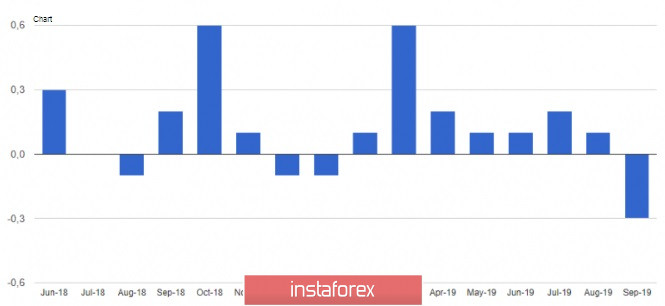
Yesterday's report on lowering producer prices in the United States and a statement by the Fed chairman limited the upward potential of the US dollar against the euro and the pound, but in general, the situation remains on the side of buyers.
According to the US Department of Labor, US producer prices for goods and services declined in September 2019, which goes against the expectations of Federal Reserve System leaders to achieve the inflation target in the coming quarters. Thus, the producer price index in September fell by 0.3% compared to the previous month, while economists had expected the index to grow by 0.1%. Compared to September 2018, the PPI index rose by 1.4%.

The report on the decline in the retail sales index did not significantly affect the US dollar. According to The Retail Economist and Goldman Sachs, the US retail sales index for the week from September 29 to October 5 fell by 1.1% but rose by 1.5% compared to the same period in 2018.
A Redbook report indicated that US retail sales fell by 1.1% in the first 5 weeks of September, while they rose by 5.7% in the same 5 weeks of September 2018.
As noted above, the head of the Fed made several important statements yesterday. Jerome Powell noted that the Fed will soon announce measures to increase the volume of bank reserves, as well as consider the possibility of buying treasury bonds to restore the reserve buffer after the recent volatility with liquidity. However, the balance sheet increase should not be confused with earlier efforts to stimulate economic growth through purchases of long-term securities (QE program).
Powell also drew attention to recently revised employment data, which shows that economic growth was more moderate last year, rather than very strong as previously expected. Many indicators point to a historically strong labor market and solid job growth that will support inflation in the future, which is slightly below the 2% target but is gradually strengthening.

The head of the Fed also expressed his attitude to interest rates, saying that the situation in the world poses risks for the prospects of the US economy, and therefore the recent reduction in rates supports the US economy. Fed leaders will continue to closely monitor the incoming data, acting expediently at the right time to maintain economic growth.
Yesterday, another important presentation was made by the new head of the International Monetary Fund and the World Bank. Kristalina Georgieva said that the prospects for the global economy continue to deteriorate, and currently, the global economy is simultaneously slowing down. The study indicates that 90% of regions around the world are facing a slowdown in economic growth this year, while back in 2017, more than 75% of regions showed an acceleration in growth. In the coming quarters, global economic growth is expected to slow to the slowest pace since the beginning of the decade. The main reason for the slowdown is trade conflicts, which will reduce the global by $700 billion by 2020.
As for the technical picture of the EURUSD pair, buyers of risky assets will try their best to return to the resistance level of 1.0975, where a large number of sellers are concentrated, hoping for a further decline in the trading instrument. The nearest major support levels are seen at yesterday's low, in the area of 1.0940, as well as slightly lower, in the area of 1.0905.
GBPUSD
Boris Johnson's Brexit plan was a failure after yesterday's heated statements and accusations from the EU. The UK government has already admitted that finding a solution before October 31 is unlikely. After a telephone conversation between Johnson and Merkel, it became clear that a compromise is unlikely to be found, which led to a sharp decline in the British pound. In Brussels, the focus is now only on further extending the terms of the UK's exit from the EU until next summer. However, Prime Minister Boris Johnson continues to insist that the UK will leave the EU on October 31 with or without a deal. Let me remind you that the recent decision of the UK Parliament prohibits withdrawal from the EU without reaching an agreement.
Uncertainty in this matter will continue to put pressure on the pound, and from a technical point of view, an unsuccessful return to the resistance of 1.2240 may be a clear signal for the resumption of the bearish trend and the renewal of the next monthly lows in the area of 1.2170 and 1.2110.